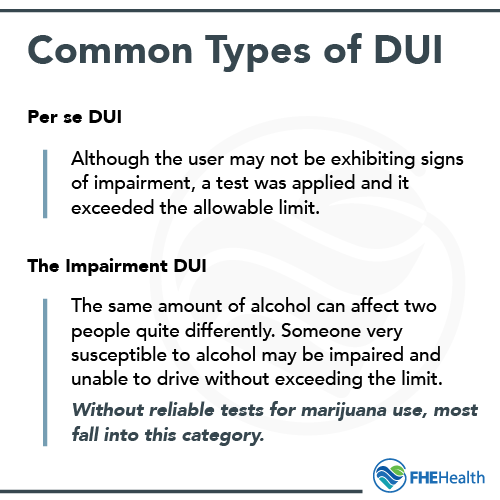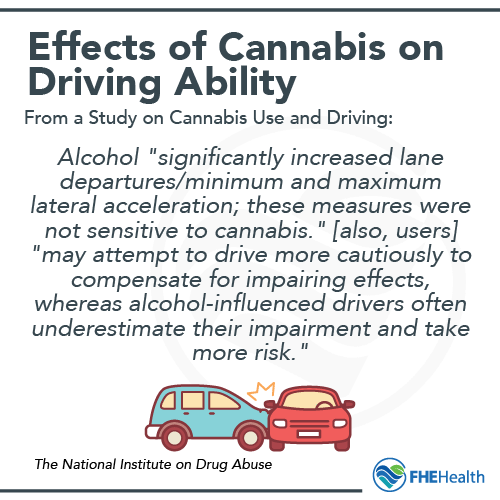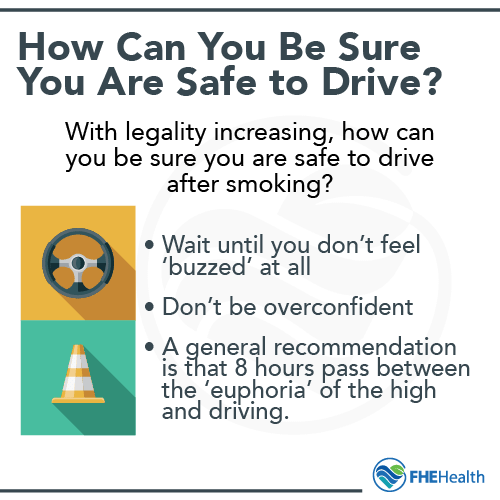
In December 2019, legal marijuana sales began in the state of Michigan, the 11th state to take the ban on recreational use of the drug off the books since Colorado and Washington became the first to do so in 2012. As of the end of 2019, 33 states currently allow people with a doctor’s permission to use marijuana. Understandably, in this time period, legal use of the drug has skyrocketed.
There has been some debate about whether weed should be legal. It’s not innately dangerous in moderation, similar to like alcohol, but like other legal drugs, use can easily lead to misuse. And even when used in reasonable doses, marijuana can cause some potentially dangerous side effects.
One of these consequences has to do with smoking weed and driving. More people are smoking, meaning that more people are likely getting on the road after partaking of marijuana. What are the dangers of this behavior, and why do weed’s unique physiological effects on its users present a particular risk when it comes to driving?
The Laws Around Smoking Weed and Driving
While the consumption of marijuana in any form is legal in more states today than ever before, recreational use is still illegal in almost 80% of the United States. But even in states where the drug is legal, this doesn’t apply to the roadways. In fact, as with alcohol, driving under the influence of cannabis is illegal in all 50 states.
Unlike alcohol, though, the standards for driving under the influence (DUI or DWI) of marijuana involves a lot more grey area than a DUI involving alcohol. Here’s why.
Two Types of DUI

This is what it’s called when a driver is under the influence of any substance, is stopped or pulled over, given a field sobriety test and fails, meaning that the arresting officer judges them to be unable to responsibly operate their vehicle. In most states, an impairment DUI doesn’t need to identify the substance. It just means that a driver is so clearly impaired they’re judged to be taking a risk by being on the road and, therefore, subject to arrest.
Sometimes, if a law enforcement officer suspects that the driver is drinking, they will administer a breathalyzer test to identify the driver’s blood-alcohol level. In most states, anything over 0.08% is grounds for a DUI/DWI charge.
Here’s where the issue gets more complicated. Driving stoned is not like driving drunk.
With alcohol, the blood-alcohol level in a person’s system is directly indicative of their level of impairment. With a person driving high on weed, there’s no such test that indicates that they’re impaired because of marijuana use.
This is because THC, the psychoactive cannabinoid in marijuana, is stored in your fat, and as such, stays in your system for much longer than alcohol. A blood, hair or urine test can sometimes detect the presence of marijuana from up to a month previous (or longer), even if that person only used the drug once.
The second type of DUI standard is a per se DUI. This means that some kind of body toxicity test shows that the level of a controlled substance surpassed the legal limit when the arrest occurred. Since many states haven’t set standards on what a safe level of weed in the bloodstream is, if a blood or other test comes back dirty — even if it’s a tiny amount — you may find yourself subject to a fine, loss of driving privileges or worse.
To review, weed stays in your system for weeks, and, in most states, if you’re pulled over with any in your system, you could be arrested for it.
Smoking Weed While Driving: A Public Health Risk

There’s a prevailing belief that people can drive just as well under the influence of marijuana as they can sober. The verdict is still out on the degree to which this is a myth, but multiple studies corroborate the fact that marijuana does impair users’ driving abilities, especially in high amounts.
Weed is a central nervous system depressant, and its effects on a driver’s motor functions and reaction times are thought to be similar to another CNS depressant: alcohol. One study found that impairment caused by smoking marijuana was less than that of drinking, but driving after smoking is still a risk factor for roadway accidents.
While some disagree with what has been called a double standard applied to drinking while driving and smoking while driving, it’s hard to deny that, in large enough concentrations, the effects of marijuana on the ability to safely operate a vehicle are negative.
How Are Lawmakers Responding?
Driving high on weed is certainly nothing new, but new laws are bringing it to the forefront now that much of the cannabis found in drivers’ systems are being acquired legally. With this in mind, have the laws adjusted to meet the behavior?
In some states, there’s been movement, but little else. In light of the difficulty law enforcement faces when trying to assess whether a person’s marijuana use has made them unfit to drive, many states are re-examining their DUI standards. One where it’s surprising that nothing has happened over six years since pot was legalized in its borders is Colorado.
HB19-1146 is a law brought to the Colorado house floor in various forms since legalization occurred. Basically, it sets new standards on DUIs that would mandate that per se DUIs also meet the impairment standard. This is good news for responsible weed smokers, but it should be noted that in this, one of the most permissive states in the union, nothing meaningful has been passed since full legalization.
Steps You Can Take to Mitigate Risk

If you’re a frequent user and looking for a solution that allows you to keep using pot and driving, current laws simply don’t make one available. Even if you’re extremely careful and wait until you no longer feel the effects of the drug before getting behind the wheel, you could still be at-risk for a per se DUI if you get pulled over.
The best way to ensure that you don’t experience negative consequences of smoking pot and driving is to quit entirely. But this may be easier said than done.
Marijuana Addiction Is Real
Some people will tell you that cannabis isn’t addictive. You may not believe that marijuana can produce a chemical addiction similar to other substances such as alcohol and opiates, but there is such a thing as addiction to a behavior.
Anything that’s pleasurable or therapeutic is an easy source of dependence and addiction, and no matter which way you look at it, marijuana definitely fits in that category. Take it from one former patient at FHE Health, who describes how difficult it is to quit using the drug.
Breaking dependence on marijuana can be extremely difficult, but there’s no shame in asking for professional, experienced help. At FHE Health, we help people suffering from chemical and behavioral addiction using evidence-based treatment methods and compassionate support. If you or a loved one is struggling with decreasing or stopping cannabis use, contact us today to learn more.






